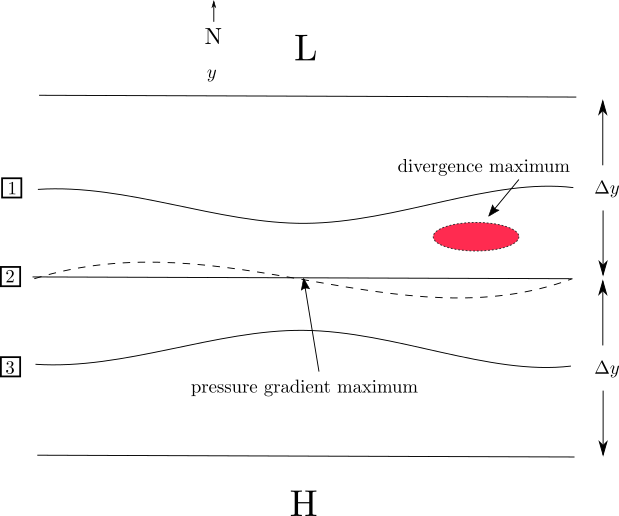
| Science 123 | Spring 2020 | |
Jet Streak Flow Pattern |
The figure below shows an idealized pressure or height contour pattern associated with a jet streak. The contours "pinch" together to create an increasing and, then, decreasing pressure gradient at the center of the pattern.

Three parcels, numbered 1- 3, are entering the streak on the left-hand side. Parcels 1 and 3 will follow the solid contour on which they enter. The average pressure gradient force, given by $\frac{\Delta P}{\Delta y}$ ($\Delta y$ does not change between the pressure contours to the north and south of the parcels), does not effectively change for them as they pass through the jet streak so they will follow the countour in either geostrophic or gradient wind fashion.
However, parcel 2 will follow the dashed-line path, deviating from the path determined by pressure contour (indicated by the solid line) upon which it enters the jet streak because it experiences an increasing pressure gradient as it enters moves to the center of the streak. This increase in pressure gradient force will, initially, exceed the Coriolis defelection causing the parcel to vear slightly to the left, down the pressure gradient and towards the low. The increasing pressure gradient force will eventually cause an increase in the parcel's speed that increases the Coriolis deflection. However, once the parcel passes the point of maximum pressure gradient and the pressure gradient force on the parcel begins to decrease, the Coriolis deflection is now greater than the pressure gradient force and the parcel will deflect to the right of its gradient or geostrphic path. This occurs in the region of "natural" path divergence, so the over-reaction of the Coriolis deflection down stream from the pressure gradient maximum adds to the already present path divergence. This combined effect creates a region of enhanced divergence in the left exit flank of the jet streak.